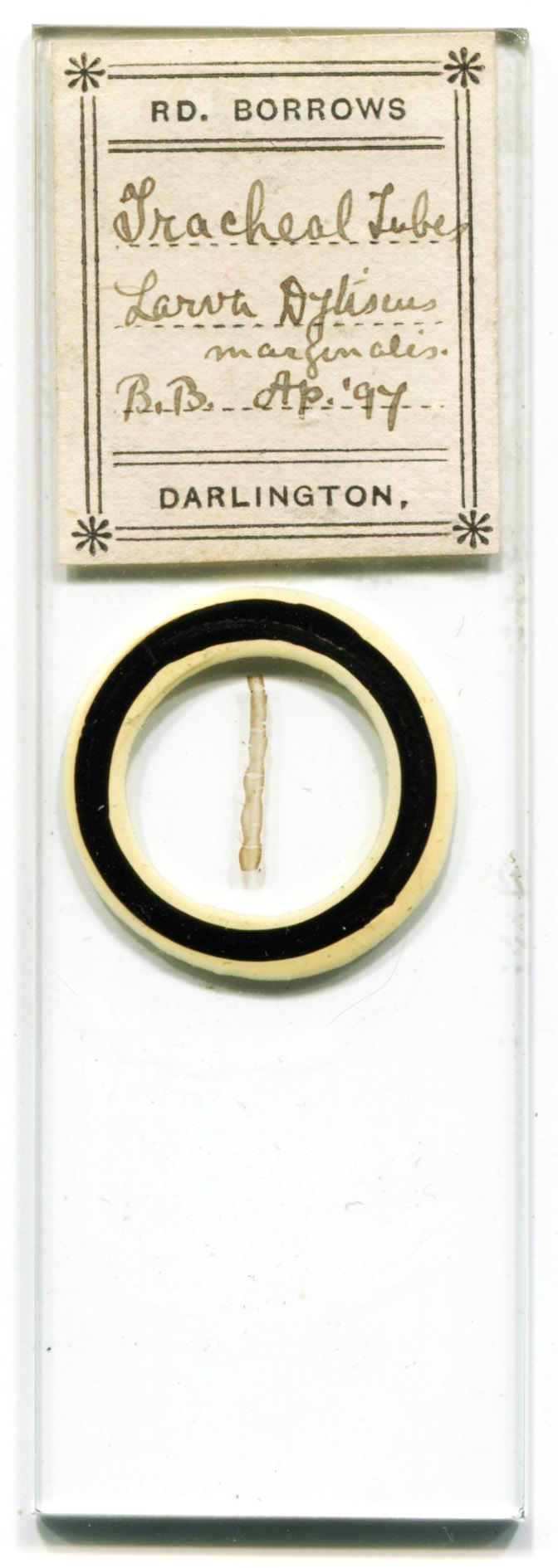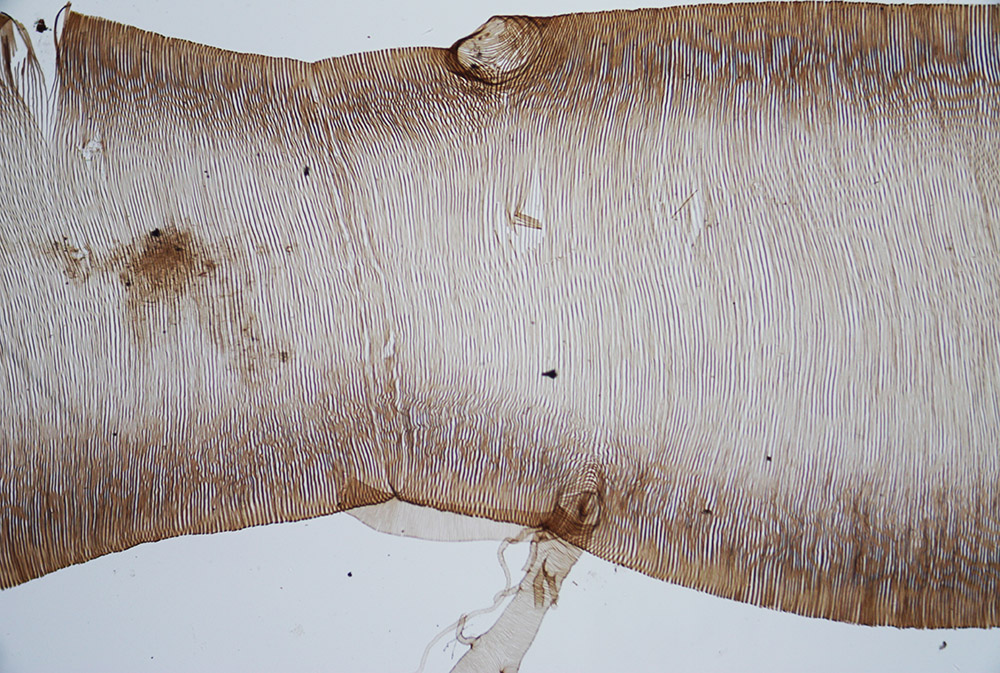Richard Borrows, 1864 - 1945
by Brian Stevenson
last updated September, 2019
Borrows was an amateur microscopist, active during the late 1800s and early 1900s. Through that period, he worked in newspaper printing offices, primarily in Darlington, Durham, England. Borrows’ microscope slides bear attractive, custom-printed labels (Figure 1). Considering Borrows’ occupation, it is likely that he printed the labels himself.

Figure 1.
“Tracheal tubes larval Dytiscus marginatus” (the great diving beetle), mounted by Richard Borrows during April, 1897. The initials “B.B.” probably refer to benzole balsam, a popular mountant. A contemporary recipe for this variant of Canada balsam is included at the end of this essay.

Figure 2.
Magnified view of the D. marginatus tracheal tubes (Figure 1). Photographed with a C-mounted digital SLR camera and a 10x objective lens.
Richard Borrows was born on November 23, 1864, in Normanby, Yorkshire. He appears to have been the eldest of three children of George and Dorothy Borrows. Father George was a “shoemaker”, according to the 1881 census. At that time, the family lived in Brotton, Yorkshire, and 16 year-old Richard was already working as a “printer”.
Richard married Hannah May Ayscough during the spring of 1886. Their only child, Richard Leonard Ayscough Borrows, was born in 1907, when Richard and Hannah were well into their 40s.
By the time of the 1891 census, Richard and Hannah had moved to Stockton-on-Tees, Durham. His occupation was listed as “printers compositor”.
Borrows moved to Darlington by 1895, working as a foreman for the Northern Echo newspaper. He was mentioned in a write-up on that newspaper’s Christmas party: “On the morning of the 22nd Dec, the news hands on the staff of the Northern Echo, Darlington, held their annual ‘whiskey drink’ - a title which, by the by, was this year a misnomer, seeing that teetotalers were in the majority. Mr. Johnson, chapel treasurer, was unanimously voted to the chair. The proceedings commenced about two o'clock, when a substantial repast, provided by Stewards J. Mount ford and Geo. Rogers, was partaken of. After the ‘removal of the cloth’ (which, by the way, was an imaginary one!) a long and interesting programme was gone through. ‘Success to the Northern Echo’ was enthusiastically drunk on the proposal of the editor, Mr. J. Marshall. Songs were rendered by the following: Messrs. D. Robinson and S. Carlton (stereotypers), Mr. J. Moses (sporting editor), Messrs. G. Rogers, H. E. Moore, Thompson, Garneys, and Harwood; readings by Mr. J. Moses and Mr. R. Borrows (foreman, jobbing department), and recitations by Messrs. Moore and Robinson. A very enjoyable time was experienced by all, and the party broke up at 4.30 a.m. by singing ‘Auld Lang Syne’."
His position as a foreman suggests a rise to the middle class, and may coincide with Borrows’ interests in microscopy and other hobbies. The slide illustrated in Figure 1 is dated 1897. A common means for a microscope enthusiast to share and acquire new slides was to post exchange offers in popular magazines such as Science-Gossip; I identified only two exchange advertisements from Borrows, published in 1898 and 1901 (Figure 3).
Borrows was also interested in amateur photography, and was active in the local Darlington Camera Club. In 1902, he won first prize in “a competition in developing a plate of unknown exposure”.
The Borrows family moved at least twice during the late 1890s, presumably associated with relocations to other newspaper offices. During the autumn of 1898, they moved to Blackpool, Lancashire. Richard was evidently worried that he might miss messages from other microscope enthusiasts, and so published a change-of-address notice in the October, 1898, issue of Science-Gossip. The 1901 census, held in March, found the Burrows in Ashington, Northumberland. Richard’s occupation was listed as “manage printing works”. By April, 1902, the Borrows were back in Darlington, and Richard was once again working for Northern Echo.
The 1909 Botanists’ Directory listed “Borrows, R., - 22, East Mount Terrace. Darlington, Durham. E. (Diatom, Exchange.)”, indicative of ongoing enthusiasm for microscopy. A recently-published note by David Walker suggests that Borrows continued to make microscope slides through at least 1921.
On the outbreak of World War 2, a special census was taken in the U.K. Richard and Hannah Borrows then lived in Portsmouth, Hampshire. He was described as “journalist - retired”. Richard died in Portsmouth during late 1945, aged 81.

Figure 3.
Offers from Richard Borrows to exchange microscope slides and materials. Both from “Science-Gossip”, published in June, 1898, and April, 1902.
Benzole Balsam
Slides by Richard Borrows are known to be marked with the initials “B.B.”, such as that illustrated in Figure 1. This likely refers to the use of benzole balsam as the mountant (by comparison, many earlier microscope slides are known that bear the initials “C.B.”, indicating Canada balsam). The following recipe for benzole balsam was published by Mordecai C. Cooke in his 1900 issue of One Thousand Objects for the Microscope:
“Benzole balsam is prepared by evaporating the balsam on a water bath, or on a hot plate, until it becomes a solid, almost like pine rosin, and afterwards breaking it up, and dissolving in benzole, until the mixture is about as thick as cream. When thoroughly dissolved and smooth, it may be transferred to the balsam bottle for use. Should the balsam, in the course of time, become too stiff, through evaporation of the benzole, this may easily be remedied by the addition of more benzole, until the desired consistency is obtained”.
Resources
Black and White Budget (1902) “An experience of mine at eleven years of age is always a nightmare to me. I used to take my father's, dinner to some works, and on the way I went by the mineral railway. If I got the chance, unseen by the engine-driver, I often jumped up between the trucks of ironstone and rode to the works. One day I slipped just as the train reached a high wall, with the result that I was dragged for about fifty yards with both legs on the metals of the railway. I recovered the step, however, and got home without losing my legs. - R. Borrows Northern Echo Office, Darlington”, Vol. 6, page 455
Black and White Budget (1902) How I would spend £1000 competition: “I Would spend £350 on a nice little cottage, have a month's holiday to recuperate after the shock; buy my I sister an extra birthday present (as her birthday is on the 25th); lay the remainder out in a safe 3 per cent investment, and then work on for a few more years as if I had not a small fortune laid by. - R. Borrows, Northern Echo Office, Darlington”, Vol. 6, page 470
The Botanists’ Directory (1909) “Borrows, R., - 22, East Mount Terrace. Darlington, Durham. E. (Diatom, Exchange.)”, page 151
The British Printer (1895) Report on the Northern Echo’s “whiskey drink”, Vol. 8, page 18
Cooke, Mordecai Cubit (1900) One Thousand Objects for the Microscope, Frederick Warne & Co., London, page 48
England census and other records, accessed through ancestry.com
The Photographic News (1902) “The Darlington Camera Club spent a very successful and instructive evening on the 2nd inst., when the second developing contest took place with pyro versus hydroquinone, under the same conditions as the previous week. A competition in developing a plate of unknown exposure was also held, and the first prize awarded to Mr. R. Borrows”, Vol. 46, page 587
Science-Gossip (1898) Exchange offer from Richard Borrows, Vol. 5, page 32
Science-Gossip (1898) Change-of-address notice by Richard Borrows, Vol. 5, page 160
Science-Gossip (1902) Exchange offer from Richard Borrows, Vol. 8, page 352
Walker, David (2015) Tough teeth - the radula of the common limpet, Micscape, May issue, http://www.microscopy-uk.org.uk/mag/artmay15/dw-radula-new.html


